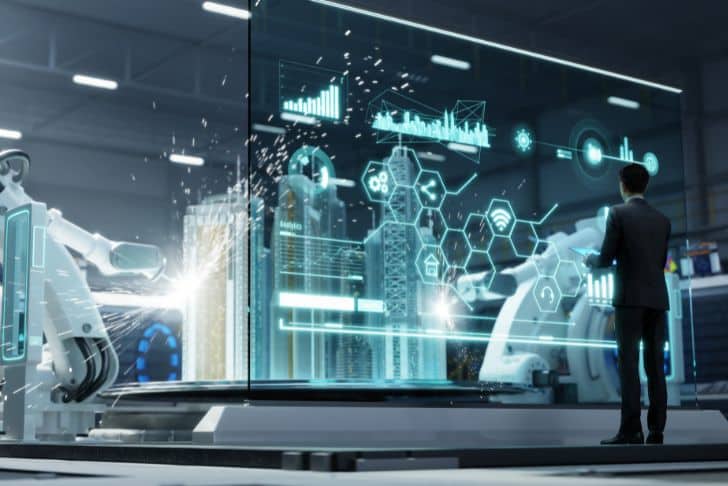Navigating the automated business world can seem like learning a new language. When understanding the dynamic relationship between Digital Process Automation (DPA) and Robotic Process Automation (RPA), it’s crucial to recognize that both are powerful, yet distinct aspects of automating your business processes. DPA, orchestrating bots, people, data, and systems, focuses primarily on streamlining manual tasks in a workflow, including those involving Artificial Intelligence. Implementing DPA, for example, during new employee onboarding can bring efficiency, saving time and resources.
Conversely, RPA works by mimicking human interaction with digital systems for rule-based tasks, excelling at automating repetitive tasks void of cognitive decision-making. Though RPA can operate independently, it’s frequently part of DPA’s broader automation workflow. Both act as integral components of a comprehensive approach to business automation, better known as hyperautomation. As the business landscape continues to evolve, Gartner predicts immense growth in the software services and application infrastructure sectors. Understanding the key roles and interplay of DPA and RPA can be game-changing in fully optimizing business automation.

What is Digital Process Automation (DPA)
Defining DPA
Digital Process Automation (DPA) is a modern approach to workflow automation, that entails the orchestration of people, bots, data, and systems to automate as well as augment operational processes. DPA goes beyond simple task-based automation, it reimagines the entire process, including decision-making and communication to create more efficient workflows.
Components of DPA: People, Bots, Data, and Systems
People, bots, data, and systems are key components that make DPA possible. Humans are involved in managing processes and making strategic decisions, bots are responsible for automating repetitive tasks, data is used for insights and decision-making, and systems facilitate the entire operation aligning all the components together.
Role of Artificial Intelligence in DPA
Artificial Intelligence plays a significant role in DPA. AI is vital in automating processes that involve complex tasks and decision-making that usually require human intelligence. Through machine learning algorithms and natural language processing, AI can learn, adapt and make decisions, accelerating processes while lessening the load on humans.
How does DPA work?
DPA works by firstly understanding the current process, then reimagining and redesigning the same digitally, ensuring all actions, data transfers, and decisions are accurately mapped. Then, the repetitive tasks in that process are automated using bots, and critical decisions are either automated using AI or directed to humans.
Advantages of DPA in businesses
Implementing DPA can lead to considerable advantages in a business setting. The key benefits being time and cost savings by reducing the time spent on manual, repetitive tasks. It also helps in eliminating human errors, giving your team the capacity to focus more on strategic and innovative tasks. DPA also enables better tracking, management, and improvement of processes.
Understanding Robotic Process Automation (RPA)
Defining RPA
Robotic Process Automation (RPA) is a technology that mimics human interactions with digital systems and automates rule-based tasks. It’s essentially a software robot or “bot” that can log into systems, enter data, compute and complete tasks, and then log out.
How RPA mimics human interactions
RPA bots work by replicating the actions that a human would perform on a computer. They connect to the system like a human user, read the digital output from the computer screen, interpret it, take decisions, and perform tasks just as a human would.
What tasks are suitable for RPA?
RPA is very useful for automating repetitive tasks that do not require cognitive decision making, such as entering data into systems, exporting and importing data between different systems, performing calculations, and creating reports.
Functioning of RPA
RPA operates by interacting with systems at the user interface level, just like human users do. It follows predefined rules and steps to performing tasks and can work continuously without breaks, making it ideal for tasks that involve large volumes of data or need to be performed repetitively.
Differences Between DPA and RPA
Task types handled by DPA vs RPA
The tasks automated by DPA and RPA differ in complexity and nature. DPA is used for automating entire workflows and decision-centric processes which usually require human intervention. On the other hand, RPA is more suitable for routine, rule-based tasks where human cognitive skills are not essential.
Role of cognitive decision-making in DPA and RPA
In DPA, the role of cognitive decision-making is significant. DPA usually automates more complex processes that require decision-making based on data analysis and interpretation. RPA, however, is typically used in tasks that do not need cognitive decision making as they follow specific rules and patterns.
How DPA and RPA interact with digital systems
While both DPA and RPA interact with digital systems, the level and mode of their interaction vary significantly. DPA involves a deep interaction as it deals with process-level automation and requires the integration of different systems. RPA interacts at a superficial level as it replicates the actions performed by humans on digital interfaces.
The Interplay of DPA and RPA in Business Automation
How DPA and RPA complement each other
RPA and DPA, despite their differences, complement each other in process automation. While RPA automates routine tasks, DPA takes care of complex decision making and coordinates end-to-end process execution, making them a powerful duo for enhancing business efficiency.
RPA as a component of DPA workflows
RPA often forms a component of DPA workflows. In such setups, DPA handles the overall process orchestration, and where it encounters a repetitive task, the RPA bots are leveraged.
Use cases highlighting the interplay between DPA and RPA
Onboarding of new employees is one of the many areas where DPA and RPA can work together. The overall process can be managed by DPA, with RPA bots performing tasks such as user account creation, access allocation, initial communication with the employee, and so on.

The Role of DPA in Employee Onboarding
How DPA helps in onboarding new employees
DPA can streamline the entire onboarding process, cutting down the time taken to set up a new employee. It ensures every process step is followed, nothing is missed, and everyone involved in the integration is informed and aligned with the tasks they need to perform.
Example cases where DPA has improved the onboarding process
Many businesses have successfully implemented DPA in their onboarding process. A good example is how efficiently the process can kick off as soon as the new employee signs their contract. The DPA system can trigger a series of tasks such as preparing the workspace, arranging the required tools, setting up necessary training, communicating with the relevant teams, and much more.
The Function of RPA in Automating Repetitive Tasks
Areas where RPA can automate repetitive tasks
RPA is extremely useful in automating repetitive tasks across various business areas. These include data entry in finance departments, generating reports in HR, monitoring and responding to simple IT issues, and standard responses in customer service.
Benefits of using RPA in such tasks
The benefits of using RPA for repetitive tasks are many. Apart from doing the task more accurately and faster than a human, it also allows employees to concentrate on tasks that need human intelligence and creativity. Additionally, using RPA can help companies increase productivity, reduce operating costs and improve service delivery.

Concept of Hyperautomation
Understanding hyperautomation
Hyperautomation is an advanced state of automation where an ecosystem of automation technologies, including DPA and RPA, come together to augment human intelligence. Its aim is to automate as much as possible, making human intervention in processes minimal.
The part of DPA and RPA in hyperautomation
In hyperautomation, DPA and RPA play important roles. DPA handles complex workflow automation and decision-centric processes while RPA takes on repetitive tasks. Together, they bring in efficiencies and speed in processes, making hyperautomation achievable.
How hyperautomation benefits businesses
Hyperautomation has several benefits for businesses. It not only frees up employee time from mundane tasks but also offers a considerable reduction in cost and errors. It also enables agility, as with automation, businesses can quickly adapt to changes and scale operations easily.
Market Overview of Business Automation Tools
Current market situation of automation tools
The market for automation tools is vibrant and expanding, as more businesses realize the benefits of DPA, RPA, and hyperautomation. There is an increasing demand for effective tools that can automate workflows, manage data better, and support decision-making.
Expected growth of the automation market
According to Gartner estimates, the automation market is poised to see significant growth in the coming years. With businesses increasingly moving towards digital solutions, the need for automation tools will likely keep growing.
Growth prospects of DPA and RPA tools
The prospects for DPA and RPA tools are very bright. As businesses adopt comprehensive digital transformation strategies, the demand for these tools is expected to increase further. Their capacity to enhance operational efficiencies and reduce errors and costs makes them indispensable for businesses today.
Future Trends in Business Automation
Emerging trends in DPA and RPA
Emerging trends in the automation space include the greater adoption of AI and machine learning technologies in DPA and RPA tools. There’s also a growing interest in hyperautomation, as businesses take a more holistic approach to automation.
Impact of these trends on businesses
These trends will have a transformative impact on businesses. Along with operational efficiency and cost savings, automation will enable businesses to be more agile, responsive to changes, and deliver better customer experiences.
How businesses can prepare for these trends
Businesses can prepare for these trends by investing in their understanding of DPA, RPA, and hyperautomation. By recognizing the possibilities offered by these technologies and aligning their business strategies with them, they can make the most out of automation.
Drawbacks and Challenges of DPA and RPA
Common issues faced when implementing DPA and RPA
While implementing DPA and RPA, businesses often face challenges, such as a lack of understanding of the technology, resistance to change, issues with process mapping and system integration, etc. It’s essential to address these issues properly for successful implementation.
Possible solutions to overcome these challenges
These challenges can be overcome by establishing a well-structured plan for automation, providing adequate training to the employees, adopting a phased approach instead of a big bang approach, and ensuring good project management throughout the whole process. A strong partnership with experienced automation service providers can also prove beneficial.
